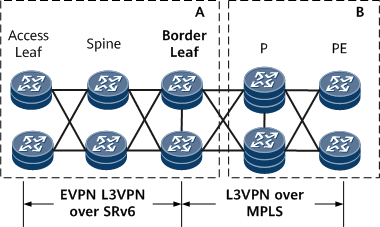Configuring Interworking Between an EVPN L3VPN over SRv6 and a Common L3VPN over MPLS
During network evolution, an EVPN L3VPN over SRv6 and a common L3VPN over MPLS may coexist. To ensure normal communication between the two types of networks, configure interworking between an EVPN L3VPN over SRv6 and a common L3VPN over MPLS.
Context
On the network shown in Figure 1, area A is a newly built network deployed with the EVPN L3VPN over SRv6 service, and area B is the legacy network deployed with the common L3VPN over MPLS service. To ensure normal communication between the two networks, configure interworking between the EVPN L3VPN over SRv6 and the common L3VPN over MPLS on border leaves.
Pre-configuration Tasks
Before configuring interworking between an EVPN L3VPN over SRv6 and a common L3VPN over MPLS, complete the following tasks:
On the network in area A, Configuring EVPN L3VPN over SRv6 BE.
On the network in area B, Configuring a Basic BGP/MPLS IP VPN or Configuring a Basic BGP/MPLS IPv6 VPN.
Procedure
- Configure a border leaf to advertise the routes that are re-originated in the BGP-EVPN address family to a BGP VPNv4/VPNv6 peer (PE).
- Configure the border leaf to advertise the routes that are re-originated in the BGP-VPNv4/VPNv6 address family to a BGP EVPN peer (access leaf).
- Enable the EVPN route advertisement in the BGP-VPN instance address family view.
- Run commit
The configuration is committed.
Verifying the Configuration
Run the display bgp evpn all routing-table command to check the EVPN routes re-originated by the border leaf upon receipt of MPLS-encapsulated VPNv4/VPNv6 routes received by the PE.
Run the display bgp vpnv4 routing-table command to check the VPNv4 routes re-originated by the border leaf upon receipt of SRv6-encapsulated EVPN IPv4 prefix routes received by the access leaf.
Run the display bgp vpnv6 routing-table command to check the VPNv6 routes re-originated by the border leaf upon receipt of SRv6-encapsulated EVPN IPv6 prefix routes received by the access leaf.
